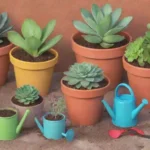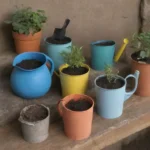Decorative Rocks: Choosing the Right Ones for Succulent Gardens

Introduction
In recent years, succulent gardens have surged in popularity among gardening enthusiasts and casual plant lovers alike. These spectacular gardens not only showcase the unique beauty of succulents, but they also offer a relatively low-maintenance option for people with busy lifestyles. A significant element that enhances the visual appeal of succulent gardens is the use of decorative rocks. Selecting the right rocks can create a harmonious balance while providing structural support and aesthetic charm to the garden.
This article serves as a comprehensive guide to understanding the various types of decorative rocks available for succulent gardens, how to select them, and tips on arranging them for maximum impact. Whether you are creating a new garden or enhancing an existing one, you're likely to find many useful insights that can help elevate your space.
Benefits of Using Decorative Rocks in Succulent Gardens
Using decorative rocks in succulent gardens offers a myriad of benefits. First and foremost, rocks play a crucial role in drainage. Succulents, by their nature, flourish in well-draining soil. Rocks can help facilitate proper water runoff, thereby reducing the risk of root rot that often occurs due to standing water. By strategically placing rocks around your plants, you promote optimal drainage while simultaneously lending an elegant look to your garden.
Moreover, decorative rocks provide an effective means of regulating soil temperature. During extreme weather conditions, such as excessive heat or cold, rocks can insulate soil temperatures, creating a more favorable environment for succulent growth. In hot climates, rocks absorb heat and release it slowly, helping to keep the soil temperature stable. Also, in colder months, they can act as a protective layer, shielding root systems from frost damage.
Lastly, rocks contribute to the overall aesthetic of the succulent garden. They can be used to create texture, contrast in color, and focal points. A carefully curated collection of rocks complements the soft, plump forms of succulents and serves as an excellent backdrop to the vibrant colors of the plants. From river stones to granite boulders, the diverse types of rocks available can significantly transform your garden's visual landscape.
Types of Decorative Rocks for Succulent Gardens
When selecting decorative rocks for your succulent garden, it’s essential to understand the various types and their qualities. Here, we delve into some popular rock types, each offering distinct benefits and aesthetic appeal.
River Stones
River stones are naturally smooth, rounded stones that have been shaped over time by the flow of water. These rocks are often available in various sizes and shades, ranging from earthy browns to subtle grays. Their natural look seamlessly integrates into garden settings, making them an excellent choice for creating soft landscapes.
 Essential Tools for Caring for Your Succulents Outdoors
Essential Tools for Caring for Your Succulents OutdoorsOne of the standout features of river stones is their excellent drainage properties. Given their round shape, they don’t stack neatly, which means rainwater can flow through them efficiently, reducing the risk of waterlogging. They can be used effectively to create pathways or borders, guiding the eye through the garden while maintaining a natural aesthetic.
In terms of styling, river stones can enhance the look of succulents by offering soft contrasts. For instance, placing brightly colored succulents against gray or brown river stones can make those colors pop, drawing attention to your plants. The variety in sizes allows for creative arrangements, where larger stones can serve as focal points while smaller stones can fill in gaps.
Lava Rocks
Lava rocks are another option that adds dramatic flair to succulent gardens. Their porous texture and irregular shapes can create unique visual contrasts among the rounded forms of succulents. These rocks are usually dark in color, which provides a striking backdrop, especially for light-hued succulents.
One of the primary benefits of lava rocks is their exceptional drainage capabilities. Their porous nature allows for airflow and helps prevent root rot while offering insulation for the soil. They retain heat, providing a warmer environment for roots during colder nights, which is particularly beneficial for succulent varieties that thrive in hot conditions.
When it comes to design, the rugged look of lava rocks can introduce a more natural, wild vibe to your garden. Arranging these rocks in a layered fashion creates depth and can turn a simple garden into an eye-catching landscape. Pairing lava rocks with vibrant succulent varieties creates a captivating contrast and can elevate the garden’s overall appearance.
Pebbles and Gravel
Pebbles and gravel are versatile options for those looking to add a ground cover to their succulent gardens. Their smaller sizes allow for easy manipulation and create an excellent base layer that can effectively aid in drainage. Available in numerous colors, shapes, and sizes, pebbles and gravel can cater to a variety of aesthetics, matching different design themes, whether rustic, tropical, or modern.
Using pebbles as a decorative layer can help suppress weeds while allowing moisture to penetrate the soil. This can be particularly useful in arid climates, where water conservation is a priority. The application of a thick layer of pebbles on the soil surface prevents evaporation and minimizes the frequency of watering required.
 Unique Hanging Accessories for Displaying Succulents Indoors
Unique Hanging Accessories for Displaying Succulents IndoorsAdditionally, pebbles and gravel can be used creatively to create paths, delineate garden beds, or even form decorative patterns around larger specimens of succulents. Mixing various colors and sizes can enhance visual interest, creating a playful yet organized appearance that invites exploration.
Choosing the Right Decorative Rocks

Selecting the right decorative rocks for your succulent garden involves considering factors such as aesthetics, functionality, and the specific needs of your plants. It’s vital to evaluate the overall design you are aiming to achieve, as well as the surrounding environment.
Consider the Size and Scale
The size and scale of your rocks are significant considerations that can dramatically impact the visual balance of your garden. Smaller rocks can offer a delicate touch, perfect for filling in around space between plants and creating a more cohesive look. In contrast, larger boulders can serve as statement pieces or focal points, drawing the eye and providing height variations that make your garden visually dynamic.
When choosing size, it’s essential to keep the scale of your succulents in mind. For instance, large boulders may overwhelm smaller plants, while tiny pebbles may not provide sufficient contrast next to a robust variety. Aim for a mix of sizes to create balance and increase visual intrigue.
Consider Color and Texture
The color and texture of rocks also play a crucial role in the overall aesthetic of your succulent garden. Rocks with a smooth, shiny surface can add sophistication, while rough, jagged stones impart a rustic feel. Evaluate the colors of your succulents and the environment around you; harmonious colors can create a serene atmosphere, while contrasting ones can lend excitement.
Always keep in mind the succulents you are planting. For instance, light-colored stones against dark green succulents create a striking visual contrast that enhances both elements. Conversely, earthy tones work well with drought-tolerant plants, emphasizing the natural beauty of a desert landscape.
 Gardening Accessories That Make Succulent Maintenance Easy
Gardening Accessories That Make Succulent Maintenance EasyMaintenance and Longevity
Finally, consider the maintenance and longevity of the rocks. Most decorative rocks require minimal upkeep — a rinse with water or an occasional brush-off is usually enough to keep them looking fresh and clean. However, some materials may fade or break down over time, so selecting durable options is advantageous for a long-lasting garden.
It’s also worth considering how the rocks will interact with your garden over the seasons. For example, lighter rocks may reflect sunlight and create a warmer environment, while darker rocks may absorb heat. Understanding these interactions can help you choose the right rocks that will not only benefit your succulents but also stand the test of time.
Conclusion
Incorporating decorative rocks into your succulent garden can take your outdoor space from ordinary to extraordinary, providing essential functional benefits while enhancing overall aesthetics. By utilizing various types of rocks such as river stones, lava rocks, and gravel, you can create a visually intriguing and well-drained environment for your succulents to thrive.
As you select rocks for your garden, remember to contemplate the size, color, and texture that would complement your existing plants. Many decorative rocks may beautifully echo the natural landscape of succulents, enhancing the harmonious vibe of your garden space. Don't hesitate to experiment with various arrangements and styles, as this can lead to delightful discoveries tailored to your personal taste.
Finally, remember that gardening is as much an expression of artistry as it is a cultivation of plants. As you embark on your journey to design your succulent garden, allow creativity to flourish and let your garden reflect your unique personality. With the right choice of decorative rocks, you can create not just a garden, but a vibrant outdoor sanctuary that brings joy and tranquility to your life.
If you want to read more articles similar to Decorative Rocks: Choosing the Right Ones for Succulent Gardens, you can visit the Gardening accessories category.
